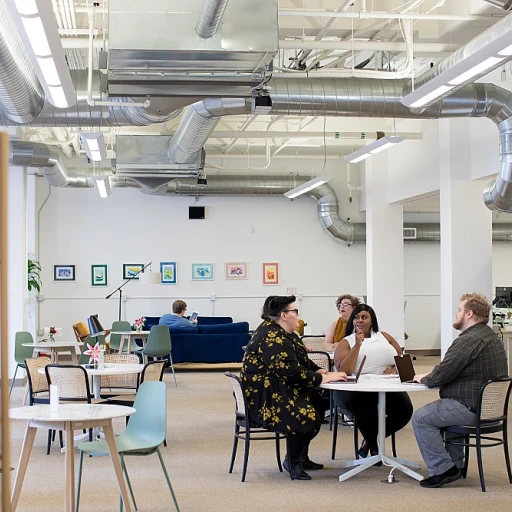
Identifying High Potential Employees
Spotting the Future Leaders in Your Team
Identifying high potential employees is a crucial step in fostering the growth of others within an organization. These individuals often exhibit a unique blend of skills and attributes that set them apart from their peers. But how do you recognize them? Here are some key indicators:
- Growth Mindset: High potential employees demonstrate a strong desire for personal growth and continuous learning. They are not satisfied with the status quo and are always looking for ways to improve themselves and their work.
- Leadership Qualities: Even if they are not in formal leadership roles, these employees naturally inspire growth in others. They often take the initiative to help others grow, showing a keen interest in developing others and contributing to the team's success.
- Adaptability: In a rapidly changing work environment, the ability to adapt is crucial. High potential employees are flexible and open to new ideas, which is essential for long-term success.
- Decision Making: These individuals are not afraid to make decisions and take calculated risks. They learn from their mistakes and apply lessons learned to future challenges.
Recognizing these traits is just the beginning. Once identified, it's important to nurture these employees through mentorship and a culture of continuous learning. This not only helps them grow but also benefits the entire organization in the long term. For more insights on how to nurture tomorrow's leaders, consider exploring insights on managers in training.
The Role of Mentorship in Employee Growth
Unlocking Potential Through Mentorship
Mentorship can be a vital catalyst in the journey of high potential employees. A solid mentorship connection will not just elevate an individual's career but can inspire growth across the team. The influence of mentorship is multifaceted and has the power to transform personal growth and leadership development exponentially over time.- Guidance and Support: A mentor provides essential guidance needed to navigate complex work scenarios. This support not only enhances decision-making skills but also reinforces the growth mindset necessary for long term success.
- Teaching by Example: A strong mentor leads by example, actively demonstrating effective leadership skills. As employees observe these behaviors, they learn to lead others, fostering a culture of growth within their teams. It becomes a reinforcing cycle where they help others grow.
- Personal and Professional Development: Mentors encourage continuous learning, aiding in both career development and personal growth. They facilitate learning others' lessons learned over time to avoid repeating past mistakes while paving the way for innovation and improvement.
- Inspiration and Motivation: Mentorship often provides the inspiration and motivation leaders need to thrive. This becomes a key driver for developing others and encourages team members to reach their full potential. Through mentorship, employees gain confidence and are better positioned to lead teams with a focus on developing others.
Creating a Culture of Continuous Learning
Promoting Self-Development and Continuous Improvement
To truly unleash the potential of high growth individuals, fostering a culture of continuous learning is crucial. Organizations that prioritize self-development and provide avenues for both personal and professional growth will find their team members not only thriving but also driving innovation.
- Encourage Growth Mindset: Promote an atmosphere where every challenge is seen as an opportunity for learning. This adaptable mindset helps individuals tackle problems with creativity and resilience, leading to better decision making and personal growth.
- Create Structured Learning Opportunities: Implement programs that focus on developing others, encouraging regular participation in workshops, seminars, and CCL classes to build leadership skills and explore new areas of interest.
- Facilitate Knowledge Sharing: Encourage team members to share lessons learned and experience with each other. When leaders and emerging leaders share their insights, it inspires growth and allows others to learn from real-world applications.
These strategies help bridge the gap between daily work tasks and long-term career development. Furthermore, fostering a culture where learning is celebrated will encourage team members to take initiative in their roles, leading to a more innovative and engaged team.
Challenges Faced by High Potential Employees
Facing the Complex Road of Professional Growth
High potential employees often encounter a set of unique challenges on their journey towards personal and career growth. While they possess the talent and the drive to succeed, these individuals can face obstacles that could hinder their development and, ultimately, affect their contributions to their teams and organizations. Balancing Short-Term and Long-Term Goals One significant challenge is managing the balance between achieving short-term objectives and pursuing long-term career goals. High potential employees need to focus on immediate tasks while keeping their eyes on future ambitions. This requires strong decision making skills and the ability to prioritize tasks that will assist in both personal growth and the growth of their organization. Navigating Organizational Dynamics Being a prominent figure in their teams, high potential employees often find themselves navigating complex organizational dynamics, which can be daunting. It's crucial for them to adapt to different leadership styles within their organizations. Understanding and learning from leaders and team members can provide valuable lessons that are instrumental in developing others and inspiring growth. Maintaining a Growth Mindset An additional hurdle is maintaining a growth mindset in the face of challenges. Unlike a fixed mindset, which can limit progress, a growth mindset encourages continuous learning and adaptability. High potential employees should strive to see obstacles as opportunities to learn and evolve in their careers. Burnout Risks High potential employees are often at risk of burnout due to their commitment to excellence and the high expectations placed upon them by leadership. It's vital for these individuals to manage their work-life balance effectively, ensuring that their personal development does not fall by the wayside. To assist in overcoming these challenges, it’s beneficial for organizations to foster supportive environments, promoting teamwork and providing opportunities for leadership development. This strategic approach not only benefits the employees but also aids in their ability to help others grow, thereby reinforcing the overall growth culture within the organization.Measuring the Impact of High Potential Employees
The Significance of Measuring High Potential Employees
High potential employees are invaluable assets to any organization, and measuring their impact is crucial to understanding how they contribute to the team's success. These employees often exhibit strong leadership qualities, making it essential for organizations to strategically assess their growth and development over time. But how exactly can we gauge the contributions of high potential employees?
One way is by closely observing their ability to inspire growth in others. High potential employees often possess a growth mindset and can effectively help others grow within the team. Their influence extends beyond personal achievements, impacting team members by fostering a culture of continuous learning and development.
- Leadership Development: Identifying how these employees contribute to leadership development within the organization is crucial. They often serve as role models and leaders, guiding team members and helping them improve their personal growth and career trajectories.
- Decision Making and Innovation: High potential employees are frequently involved in decision making processes and innovative initiatives. Tracking their involvement and the outcomes of these initiatives can provide clear indicators of their impact on the company’s long-term success.
The importance of learning from the lessons learned along the way cannot be overstated. High potential employees continuously participate in professional development activities, honing their skills and inspiring others to do the same. By carefully analyzing their influence when implementing changes or enhancing team dynamics, companies can better understand their overall value.
Another dimension to consider is how high potential employees help create a culture where people lead, learn, and work collaboratively. Observing the team's progress and interactions can offer insights into how these leaders are impacting the team's performance and morale on a day-to-day basis.
Understanding the contributions of high potential employees involves more than just recognizing their capabilities. It's about appreciating how they grow others, helping teams evolve, and promoting a culture of growth and development within the organization. With time, these efforts lead to increased employee retention and a strengthened organization overall.
Strategies for Retaining High Potential Employees
Implement Strategies that Encourage Retention
Retaining high potential employees is a priority for any organization aiming for long-term success. By handling retention strategically, companies can inspire growth within their team and cultivate future leaders. Here's how organizations can build engaging environments for high potential employees:- Offer Clear Career Pathways: Encourage employees to explore various roles within the company and provide them with opportunities to lead. This not only helps in personal growth but also contributes to the development of the organization.
- Foster a Growth Mindset: Encourage team members to embrace challenges, view failures as learning opportunities, and aim for continual improvement. A growth mindset can inspire employees to strive for excellence in their work day after day.
- Promote Continuous Learning: Providing resources and time for ongoing learning can significantly impact employee retention. Initiatives for leadership development or decision-making workshops can make employees feel valued and motivate them to grow within the company.
- Recognize and Reward Achievements: Regularly acknowledge the contributions and accomplishments of high potential employees. Recognition can be a powerful motivator and help others feel appreciated and invested in their work.
- Encourage Involvement in Leadership Development Programs: Grasp opportunities where they can learn, lead, and demonstrate their capabilities. Leadership development programs can further anchor an employee's commitment to the organization.
- Cultivate an Inclusive Workplace Culture: Prioritize creating a supportive environment where all team members feel encouraged to share their ideas and grow others through collaboration.
- Provide Access to Mentorship: A mentor can play a critical role in personal and professional development. Mentors guide high potential employees in learning others skills and achieving career aspirations.












